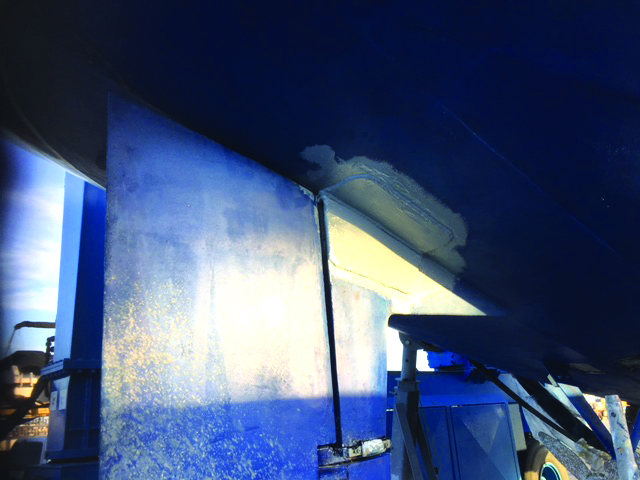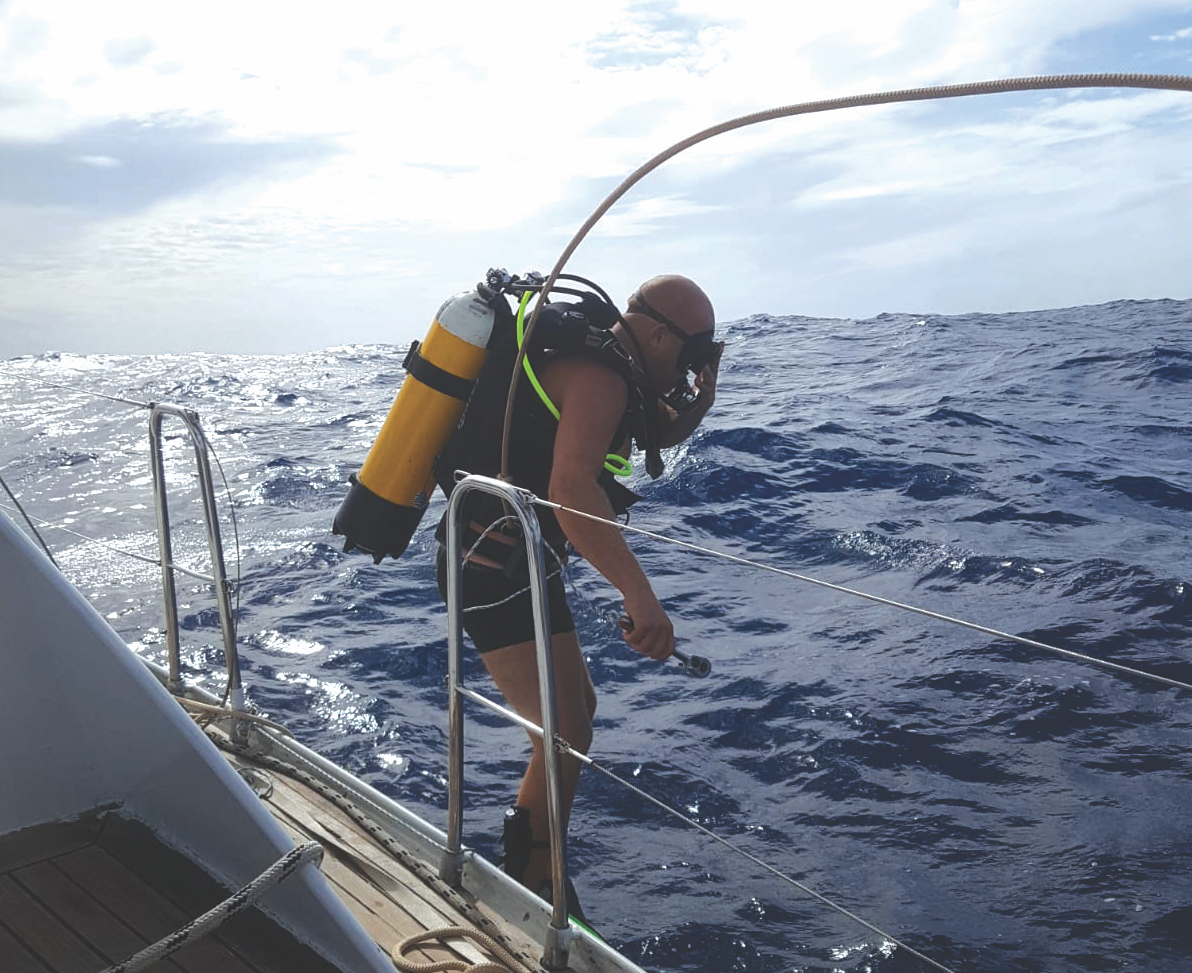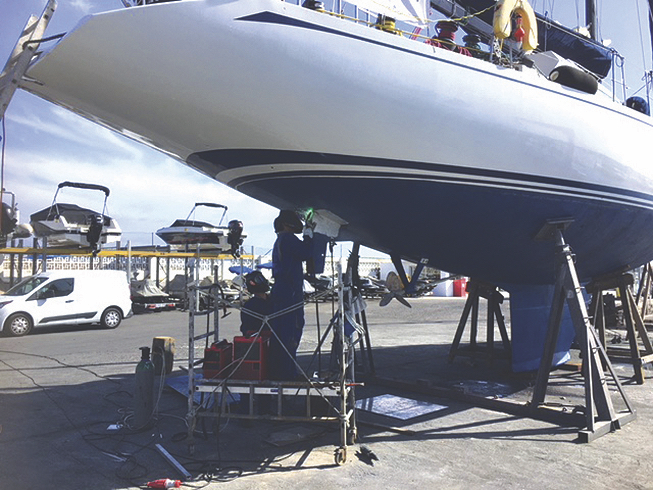When a repair to a cracked skeg leads to steering failure on an ocean crossing, dad Jarmo Lohikari dives under the hull in big swells to fix it
When my wife Teija told me she had a surprise for me one Christmas, little did I know how valuable her gift would turn out to be. “Bring your swimming trunks, and don’t ask any questions,” she said. I did as I was told, and half an hour later we were doing our first dive in the swimming pool in Helsinki.
My second dive, it turned out, would be in the middle of the Atlantic…
Teija is a nurse and I’m a plumber. We’re both experienced sailors, and I’ve lived on boats since I was four days old, returning to our house only during the winter when it got too cold.
It had been our dream to sell-up and sail around the world, starting with the Atlantic Rally for Cruisers (ARC), which departs Gran Canaria each November for St Lucia. Our daughter, Helmi was six, and would be starting school soon (in Finland, they start at the age of seven) so now was the time to do it.

EA’s crew (l to r) Sini Valaranta, Saku Sorsa, Jarmo, Helmi and Teija Lohikari
We sold our home in winter 2018 and moved onboard our 60ft Hans Groop, EA, which we’d owned for three years. Then, in the summer of 2019, we crossed the Baltic Sea and through the Kiel Canal and headed south to Gran Canaria.
When we reached Las Palmas, we were joined by our friends Saku, a marine engineer, and his able seaman girlfriend Sini – they both work on cruise ships.
Our dream had come true
When the ARC start-gun went off on 24 November our dream had finally come true. We were off – heading across the Atlantic for the Caribbean!
But as night fell, just ten hours in, we tacked and heard a loud bang. I wondered if the gas bottle had fallen over, but everything seemed to good so I went to sleep.
After an hour Teija woke me up to tell me there was a lot of water in the cabin bilge. I’d installed a new shower recently and thought maybe the hose had come off so I shut it down and pumped the bilges. Once the water was clear I went back to bed. That had to be it – there were no other options.
But an hour later Teija woke me again. “There’s a LOT of water in the bilge now,” she said.
I lifted the sole and could see water pooling around the area above the skeg. I hammered in some wooden plugs and glued a piece of plywood over the top with Sikaflex. We were going to have to turn around. We pumped the bilge again using both the hand pump and the electric pump and sailed 60 miles upwind back to Gran Canaria. By morning we were approaching land so I called the port at Pasito Blanco on the south side of the island to see if they had a boat lift. They did, so we entered the port.

The source of the leak was a crack in the skeg
When we lifted EA out and used a grinder to take a closer look at the skeg, we saw a crack. We never believed something like this could happen because it’s such a strong boat. I asked if the yard if they knew someone who could weld it, and they said yes – there’d be someone the following day.
So we took the rudder off ready and, sure enough, someone arrived the next day to start work and make the repair.

Back on the water
Once back afloat we had an enjoyable day’s sail but then the autopilot broke – it was leaking hydraulic oil. It had never stopped working before. It was really strong so we couldn’t understand what had happened. We swapped it for the spare autopilot, and spent four hours fixing the main one, before re-installing it.
The following ten days went really well – we enjoyed the sailing, but then the autopilot broke again. The kicker is also hydraulic, and this stopped working too. We managed to fix them both, but then the autopilot broke again, and we resorted to hand-steering as we only had 600 miles left to go.

Teija and daughter Helmi hand-steering after the autopilot broke
I enjoyed that actually – we got used to it. It was fun, and I really enjoyed the night watches in the moonlight. But then one evening Sini was steering and he called me on deck.
“Jarmo, I can’t steer. It’s locked on the port side.”
“You must be kidding!” I said. “That’s not possible.” But it was true.
We taped a GoPro waterproof camera to the boathook and lowered it over the side. Had we been hit by a whale or dolphin? Was there a rope or something else jammed in the rudder perhaps?
Well, we had a rudder at least. That was reassuring, but we couldn’t see what the problem was. We tried using the emergency tiller, but that didn’t help either. Something must be stuck under the hull.
Meanwhile, EA was drifting in the Atlantic swell, and the motion was becoming hard to deal with. Teija started to feel sea-sick.
We examined the photos from the GoPro. The skeg shoe supports the rudder with a lower bearing, attached by five 12mm bolts. It looked like one of the bolts had come loose and was preventing the rudder from turning freely.
Over the two weeks that we’d been steering the bolt must have worked free a little. It wasn’t so noticeable during the small movements, but when there was a big swell, and we had the maximum angle on the rudder, the forward fastening worked loose and this then prevented the rudder blade from being able to move past the skeg shoe.
By the time we’d reached this conclusion it was dark, and there was a huge swell. There was nothing we could do until morning, so we stayed inside the boat and tried to get some sleep.
I was sad and disappointed, but we didn’t panic. It wasn’t a life or death situation. We had food and water and everything we needed.
Don’t worry Daddy
Helmi was amazing. It was really, really rolly – like a washing machine inside the boat. The waves were crashing over and she asked if there was an emergency but I assured her there wasn’t, and told her to go to sleep.
She curled up on the corner of the sofa and said: “Daddy don’t you worry. I still like this sailing life. Life is good.”
She’s always encouraging me!
We left the deck lights and the running lights on and went to our bunks. Helmi slept through it all, but none of the rest us did!
I put my headphones on and listened to some Finnish music. I thought about the countryside to stay calm. Then Saku came to find me.
“Did you hear that?” he asked.
“What?”
“That noise. A bang. It sounded like a shotgun.”
We ran on deck and discovered that a rigging wire under the spreaders on the starboard side had snapped free. We had a new worry now – the mast. Because we were drifting, and the waves were battering us side-on, there was a lot of pressure on the rigging.

Jarmo prepares to secure the mast with a spare halyard (weighted by a bucket)
Saku and I used one of the spare halyards to temporarily secure the mast to the deck, then we switched our minds to stabilising the motion of the boat. We needed the drogue. I searched high and low but couldn’t find it.
Finally, Saku asked: “What colour is it? It’s not that big white thing you have in your workshop in Helsinki?”
Back to the drawing board
It was! So we needed to solve the problem another way. We decided to throw out everything we didn’t need. We attached some lines to a sailbag and threw it off the back of the boat, but it didn’t do much. Next, we took an empty spinnaker sock and filled it with water.
It was 25m long, and that really helped. It eased the side-to-side rolling, but we still needed something else.We had two dinghies onboard so decided to use the old one (deflated) as a drogue We drilled holes into the plywood, attached some lines and threw it in the water. It did the trick.
Now that the mast wasn’t moving so much we raised the sails and managed to get about 3.5 knots… in the wrong direction! We could only sail to port, and were heading to Venezuela.
We called the ARC office to let them know we had a problem. We were overwhelmed with support from other yachts, who emailed us and got in touch via Iridium sat phone to offer help. There was a catamaran, Hawkeye, 100 miles ahead of us, and they offered to turn back and give us a tow.
I was reluctant for them to do that; the seas were really rough, and to turn back into the wind and waves was not an easy thing for them to do. But they insisted. “It’s OK,” they said. “We know that you need help and we’re coming!”
It felt really good to know there were people out there with such big hearts – offering to help even though they didn’t know us. It gave us the motivation and energy to keep going, and keep troubleshooting.
A daring solution
We’ve got to find a different solution, I thought. If Hawkeye has to attempt a tow that could be dangerous for us both, and cause serious damage.
I thought back to that loose bolt under the hull. What if I could tighten it? Or bang it back into place? But the waves were huge; how could I get under the boat without hurting myself?
I considered going over the port side, but it was too dangerous. So was the stern. But the lee side might be possible. And if I attached a line underneath the hull to hang on to that would stop the boat crashing down on top of me.
I told Teija, Saku and Sini what I was thinking. They didn’t like it one bit, but agreed to let me try nonetheless. It was the only solution.
We decided to send Helmi down below while this was going on, but she gave me one last word of encouragement:
“Daddy you always fix my toys, so I know you can fix the boat!”
We attached a rope diagonally under the boat from the starboard bow to the stern quarter, so I’d have something to hold on to. The rudder is in front of the wheel so I put a lot of weight on my diving belt, and attached a rope to my dive vest, which Teija held.
I was ready to go in the water, but they kept saying “Not yet, not yet!” The waves were huge, but after seven big ones some smaller ones came along, and that’s when I jumped overboard into the Atlantic with a 7mm hexagonal wrench in my hand.

With my heart thumping in my chest, I dived under the hull and grabbed hold of the rope, holding tightly as EA lifted then accelerated at 5 knots down the face of the wave.
I found my way to the rudder, and hugged it with my arms and legs, lifting up and down with the boat’s motion, whilst trying to knock the loose bolt back into the skeg. No matter what I did, the bolt refused to budge. I banged and banged but nothing happened. It was exhausting.
My diving tank was hitting the hull repeatedly, along with my body, and I ached from the impact. Shattered, I returned to the surface and climbed back onboard.
“I know what the problem is,” I said, “but I didn’t manage to fix it.”
I was covered in bruises and when Helmi emerged from the cabin to see what was happening her eyes opened wide in astonishment.
“But Daddy, you look like a smurf!” I was covered head to toe in antifouling! I was totally blue.
After getting my breath back, I explained the situation to Saku, and wondered how the bolt might have come loose. Nine months ago in Finland we’d had to remove the rudder, and then when I put the rudder back on in Gran Canaria I used the same thread locking glue. Maybe it didn’t work anymore. I should have bought new glue.
Second time lucky
I decided to give it another go, this time with the 8mm wrench. It was so much harder to get under the boat the second time, with the increasing swell, but I was encouraged by my previous efforts. I knew the boat was OK and the hull wasn’t damaged or bending, which was a huge relief. This time I did it! The bolt went back up into the skeg allowing the rudder to finally turn underneath it.
It was just as well, because I dropped the wrench at that point, and it sunk to the bottom of the ocean! I surfaced and was splashing around and screaming with joy. Teija later told me she was terrified – she thought I’d hurt myself – but I was just really, really happy. It was the best feeling I’d ever had, succeeding like that.
When they realised I was OK, and I’d done it, they gave me a cheer and helped me back onboard. We reeled in all the drogues – the dinghy, sail bags, spinnaker sock – everything that had been trailing out behind us.
Now that the rudder was working, the first thing I did was use the sat phone to call the skipper of Hawkeye. I told him to turn back to St Lucia. They’d already sailed 60 miles upwind towards us, but instead of turning around, he agreed to slow down and wait for us. If it happened again, they’d be there to help us, and would shadow us into port. That felt really good. Though we were safe for the time-being, we couldn’t be certain the bolt would stay in place.
It’s funny, we’d been so disappointed initially when we lost the autopilot and had to hand-steer, but that became the least of our worries when the rudder failed. Now that we were back to being able to hand-steer, we were overjoyed.
We made it safely to St Lucia, and when we arrived there was a crowd of well-wishers on the pontoon in Rodney Bay waiting to cheer us in. Some of them were Finnish and they were singing our national anthem. It felt fantastic – the best feeling ever!
Expert opinion from marine surveyor, Ben Sutcliffe-Davies

Fatigue in materials such as aluminium on high load areas like a skeg are common. The old chestnut is preparation and good inspection. I’m not sure if the craft was fully inspected ashore before the voyage but the level of the failure is quite serious and I would have hoped that some flexing might have been obvious. Sometimes just flaking antifouling is enough of a clue to look a bit deeper.
If you have a steel or aluminium yacht it’s well worth cleaning back around high-load areas to see the condition of the welding. When I survey a yacht, regardless of material, I always try to put a bit of a loading fore and aft as well as side to side to see if I get any movement. It’s not clear if this was done and again potentially could have been found before it occurred.
I’ve seen the internals of this area on the photograph supplied but it’s not very obvious whether proper webs or struts were created and picked up from the internal frames to help support the skeg boxing to receive the significant loadings of the blade. Also, I would say I am not very keen on the idea of over plating.
When replacing the skeg fastenings or any underwater fastenings, including keelbolts, I always try and encourage that these are fitted new. The cost of them is insignificant against the cost of the vessel. Likewise, not using fresh thread-lock glue was unfortunate, but potentially there could have be an internal sloppiness developing in the skeg fastenings as well.
As is often the case, there were a number of failures that created a domino-effect leading to disaster. When preparing a yacht for any long distance passage, remember that help is a long way away (if at all). When competing in an event such as the ARC craft have to demonstrate a level of preparation and safety as well as undergo an independent inspection.
The problem with inspections, however, is how in-depth they go. I have before now given advice that on face value was almost laughed at but years later was told it saved the craft. For example, carrying cans of spray foam, silicone, duct tape, PVC sheet, rubble bags and bits of plywood.
■ Ben Sutcliffe-Davies is marine surveyor who is a full member of the YDSA and BMF. See more of his hints and tips on his YouTube channel via his website bensutcliffemarine.co.uk




